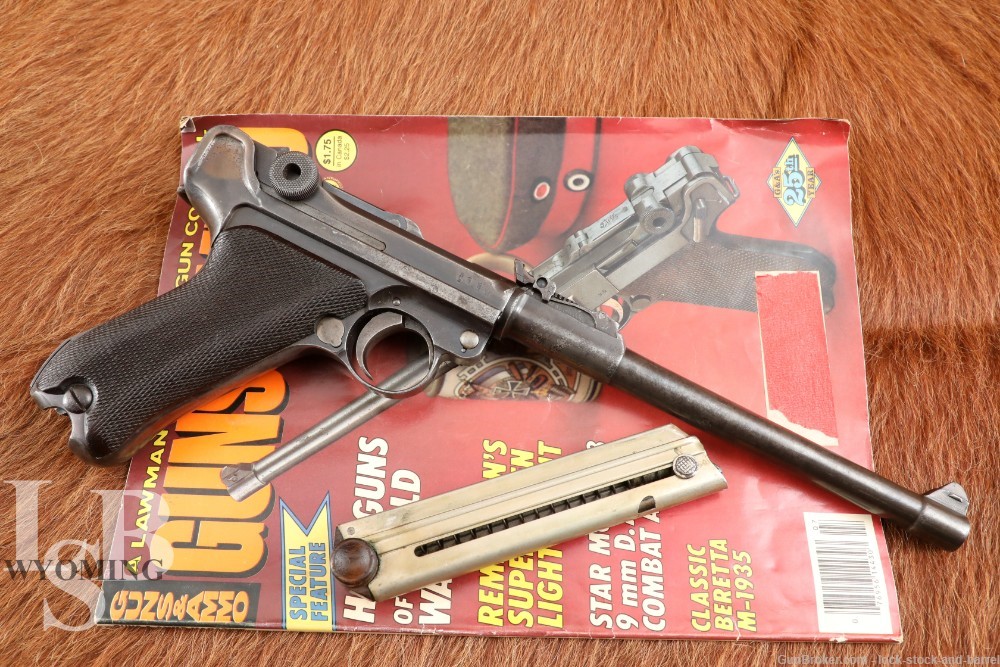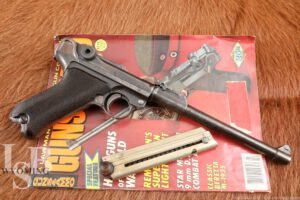
WWI German DWM P/08 Artillery Luger 8″ 9mm Semi-Automatic Pistol, 1917 C&R
SOLD FOR: $1,626.00
LSB#: WY240808RW008
Make: Deutsche Waffen-und Munitionsfabriken (DWM)
Model: Lange Pistole 08, Artillery Luger
Serial#: 6571h
Year of Manufacture: 1917
Caliber: 9mm Luger
Action Type: Semi-Automatic Pistol fed by a Detachable Magazine
Markings: The bottom of the barrel is marked “6571 / h” and “8,83”. The left side of the barrel extension is marked “6571”. The sear bar is marked “71”. The top of the chamber ring is marked “1917”. The right side of the barrel extension is marked with Imperial German inspection and proof marks. The firing pin is marked “71”. The left side of the breech-block is marked “71” and has an eagle army test proof. The extractor is marked “71”. The forward toggle is marked with the “DWM” logo and “71”. The rear toggle is marked “71”. The bolt-stop is marked “71”. The safety arm is marked “71”. The side-plate is marked “71”. The trigger is marked “71”. The takedown lever is marked “71”. The front of the frame is marked “6571 / h”. The rear sight base, arm and slider are each marked “71”. The inside of each grip panel is marked “84” (replaced).
Barrel Length: Approximately 7.9” (200mm)
Sights/ Optics: The front sight is a serrated blade dovetailed to a serrated base. The rear sight is an adjustable tangent leaf “V”-notch. The rear sight is marked 1-8, inclusive. The rear sight is a “fine-tune” sight with a spanner-wrench adjustment screw for the notch elevation.
Stock Configuration & Condition/ Grip: The grips are two-piece checkered walnut. The grips have gone to a dark color from age and oil. The left panel has a small loss at the top-rear corner under the safety. The grips otherwise show even light wear with a few scattered light marks. The checkering is generally well defined. There are no cracks. Overall, the grips are in Good-plus condition as not original to the gun.
Type of Finish: Blue and Straw
Finish Originality: Refinished
Bore Condition: The bore is semi-bright with sharp rifling. There is some scattered light erosion in the bore. In this writer’s opinion, the bore rates about 7 out of 10.
Overall Condition: The pistol retains about 25% of its current metal finish. Finish remains mostly in protected areas and around raised features. Exposed areas are mostly worn or gone to a light patina. There is odd discoloration at the top-rear of the frame. There is scattered minor surface erosion and some light oxidation. There are some light nicks, scuffs and scratches. The action shows operational wear. The screw heads are sharp. The markings are generally clear or worn, but legible; we cannot find an Imperial eagle mark on the barrel. Overall, the pistol is in Good condition as refinished.
Mechanics: The action functions correctly. The barrel assembly has minor play to the frame. We have not fired this pistol. As with all used firearms, a thorough cleaning may be necessary to meet your maintenance requirements.
Box Paperwork and Accessories: This pistol comes with a single non-matching wood-floorplate magazine and a copy of the July 1983 issue of Guns & Ammo magazine. The magazine’s special feature article is “Handguns of World War I” and the cover photos prominently features an Artillery Luger (different serial number).
Our Assessment: The Parabellum-Pistole 1908, commonly referred to as the Luger, was designed by Georg Johann Luger. Born in 1849, while attending university he served as a One-Year Volunteer with the 78th Infantry Regiment of the Austro-Hungarian Army. While in the military Luger proved himself a skilled marksman and he began to develop an interest in the small arms technology. Following service, Luger worked a number of jobs in Vienna, in the 1870s he met Ferdinand Ritter von Mannlicher who recruited him as a sales representative for Deutsche Waffen und Munitionsfabrik AG (DWM). One of the company’s weapons that Luger marketed was the Borchardt C93 (named after its designer Hugo Borchardt), criticized for being too heavy and poorly balanced. Luger decided to rework the design and eventually secured a contract for his new pistol with the Swiss Army which dubbed it the model 1900. After some minor reworking Luger introduced the Pistole 1904, chambered for 9mm cartridges, which was adopted by the Imperial German Navy, the pistol was henceforth referred to as the “Luger”. A slightly altered version of the pistol with a shorter barrel was adopted for service by the Prussian Army in 1908, hence the designation P08. The P08 would become one of the most iconic weapons of the 20th century. His pistol would continue to serve the German military during WWII (although the P38 was the Wehrmacht’s standard issue sidearm) and saw service in a number military and police forces after the war.
In 1913 Kaiser Wilhelm II, the German Emperor, allowed for the adoption of the Lange Pistole 08 colloquially known as the “Artillery Luger”. The gun featured a longer barrel, 8-position tangent rear sight and shoulder stock. Although originally intended as a defensive armament for artillery crews, the Lange Pistole was used throughout the German military, including as a carbine with a drum magazine (no drum magazine is included with the gun) by the famous Stoßtruppen (storm troopers) during WWI. Some surplus Lange Pistoles survived WWI and were eventually pressed into service during WWII, but not to the same extent as the gun had been used in the First World War.
This particular specimen is a beautiful handgun. The metal parts are serial-matching, though the grips have been replaced and the magazine is non-matching. Earliest Artillery Lugers had “fine-tune” front and rear sights, later production would go to a fixed front sight while keeping the “fine-tune” rear, and final production dropped the “fine-tune” concept entirely. This example has a fine-tune rear sight with a fixed front sight. Also included is a very neat 1983 edition of Guns & Ammo magazine which has a special feature on the handguns of WWI. This is a great option for historical firearms collectors and will display well with the included magazine. Good luck on your bid!
Please forgive any typos, I was educated in California. -Bud

